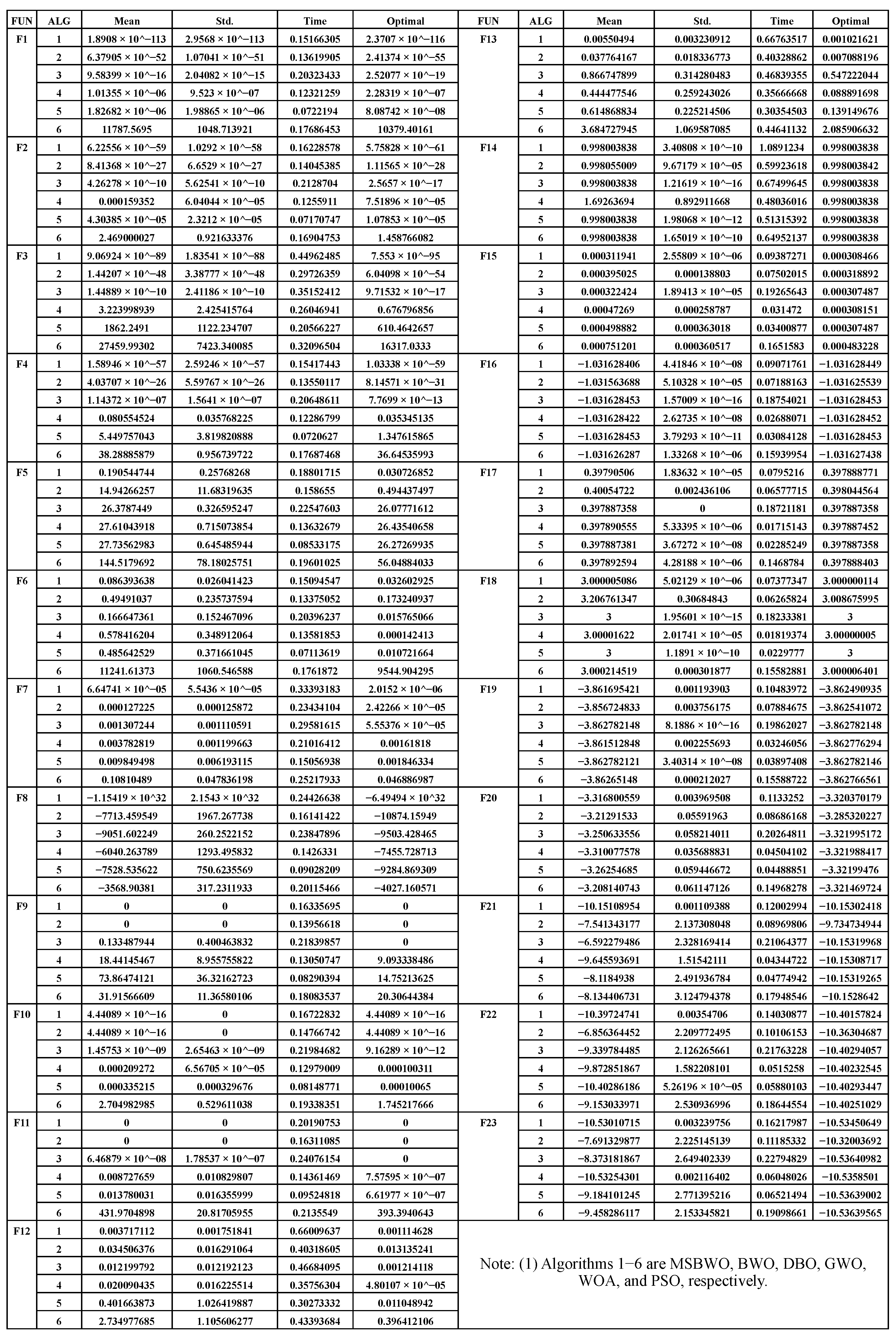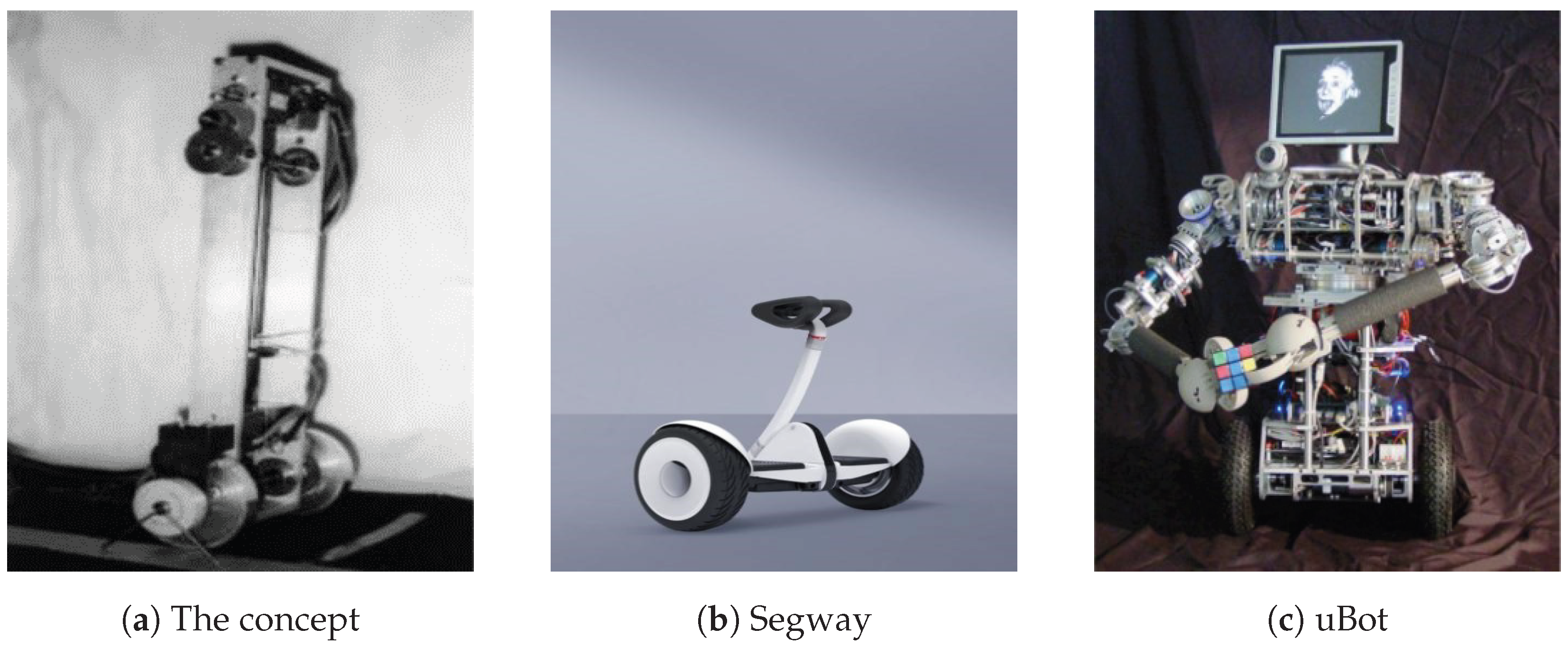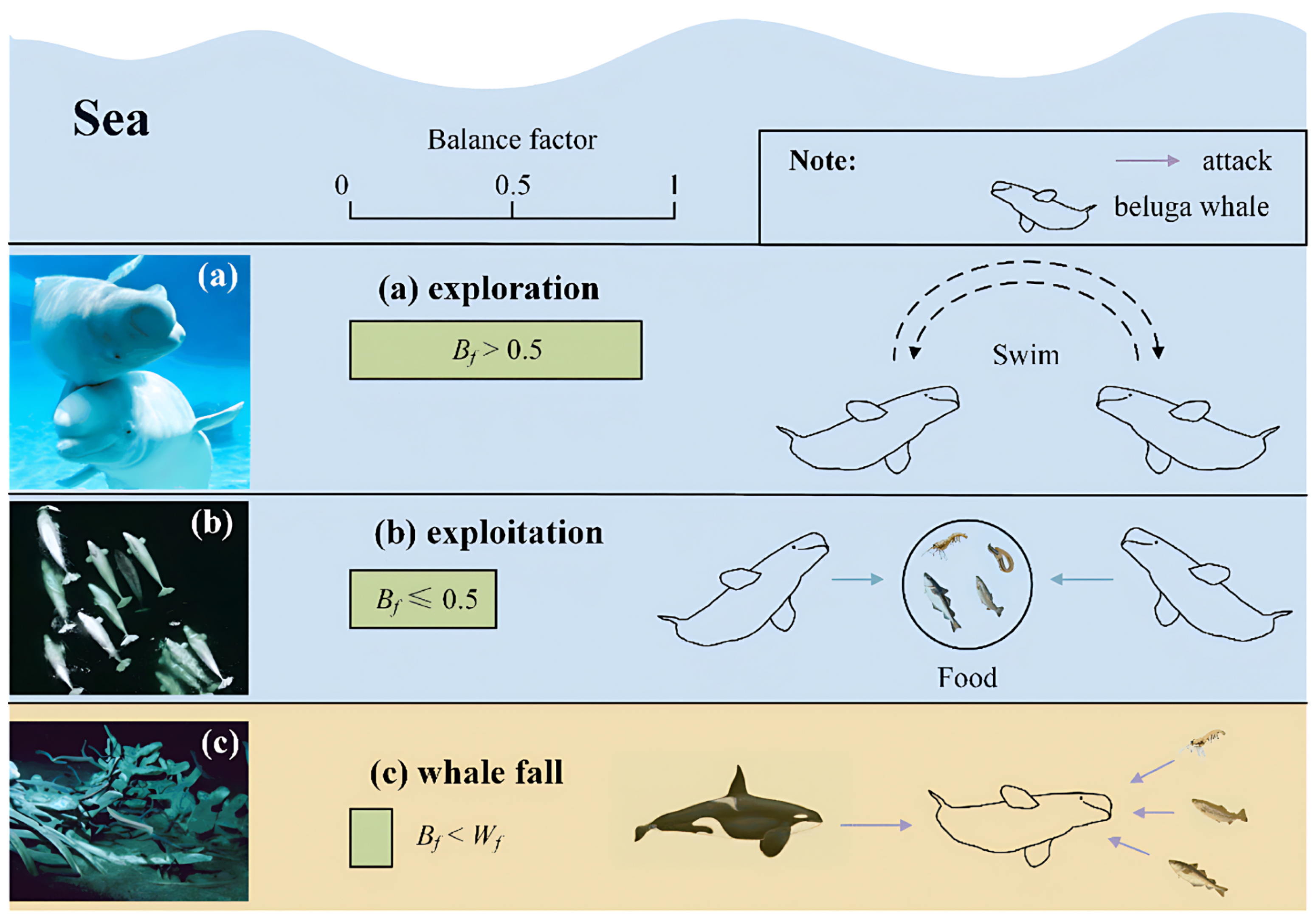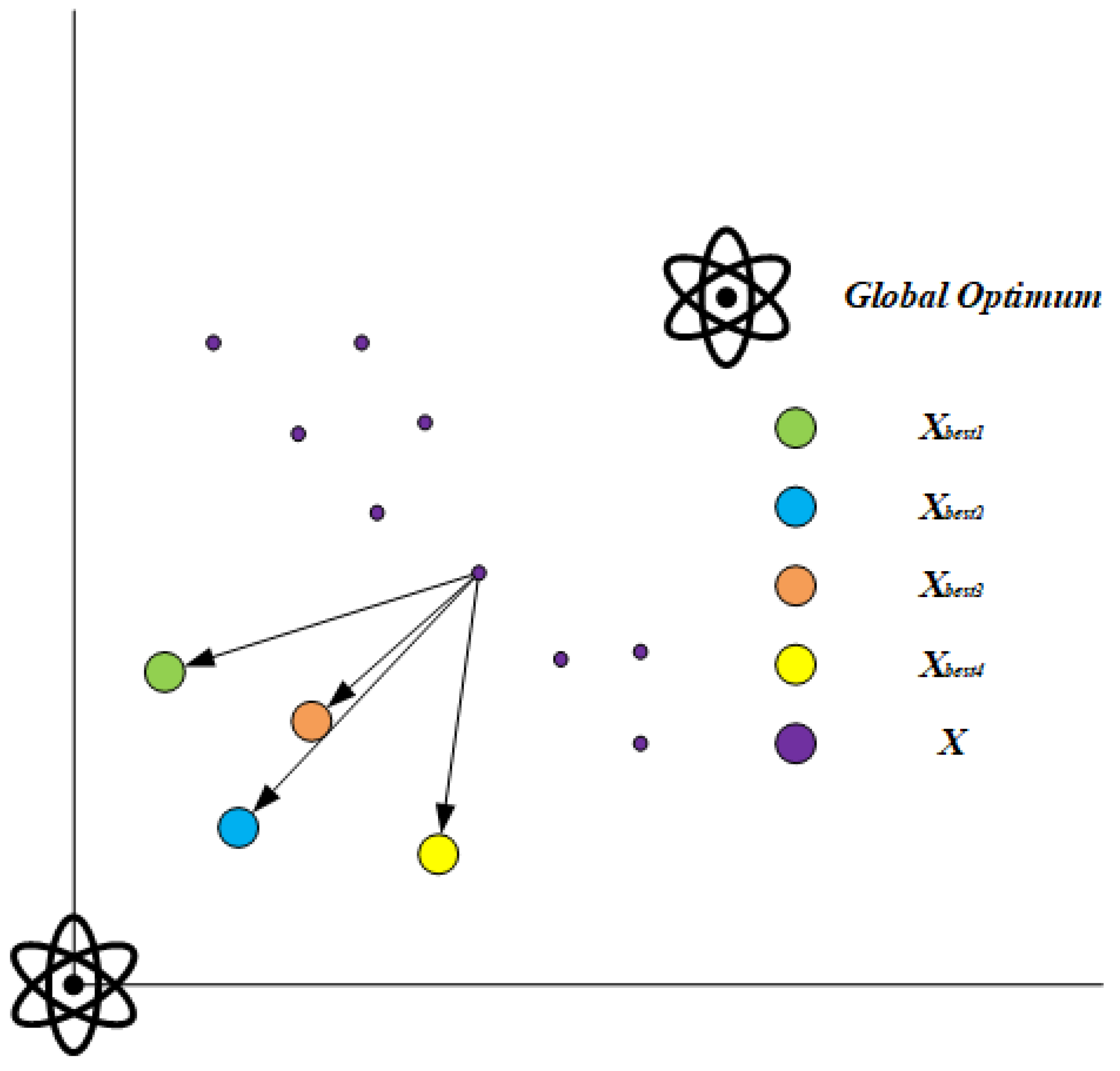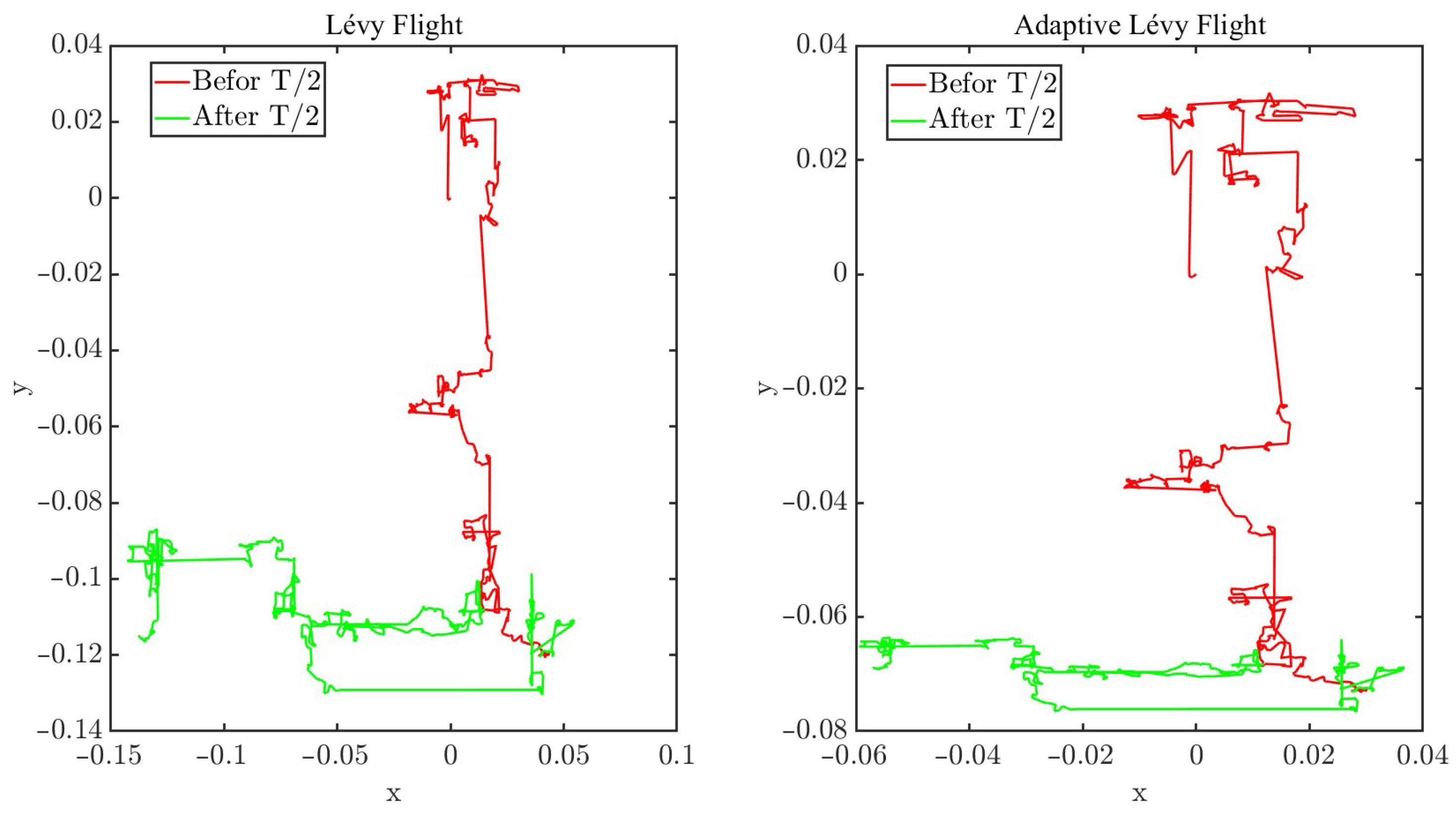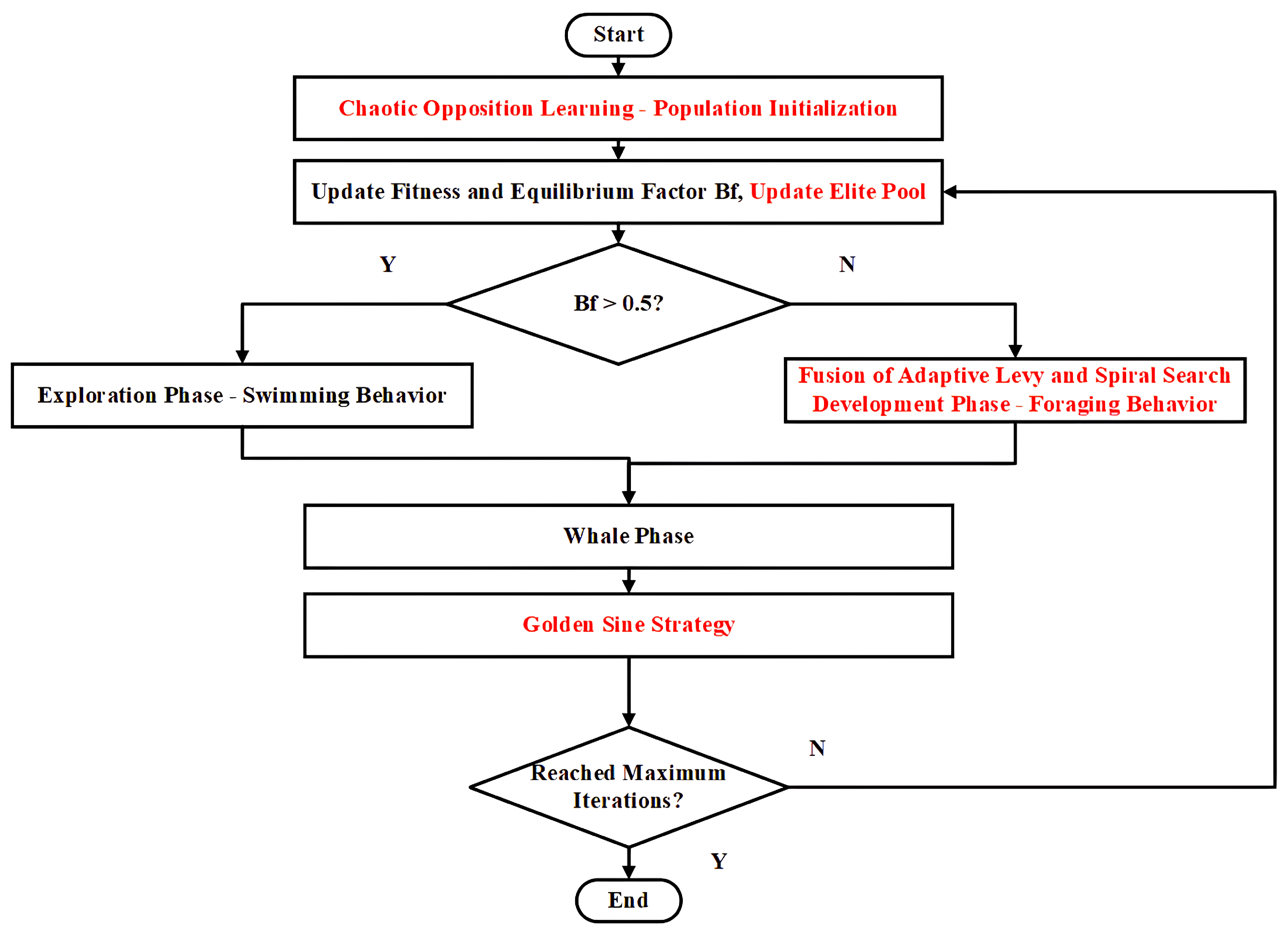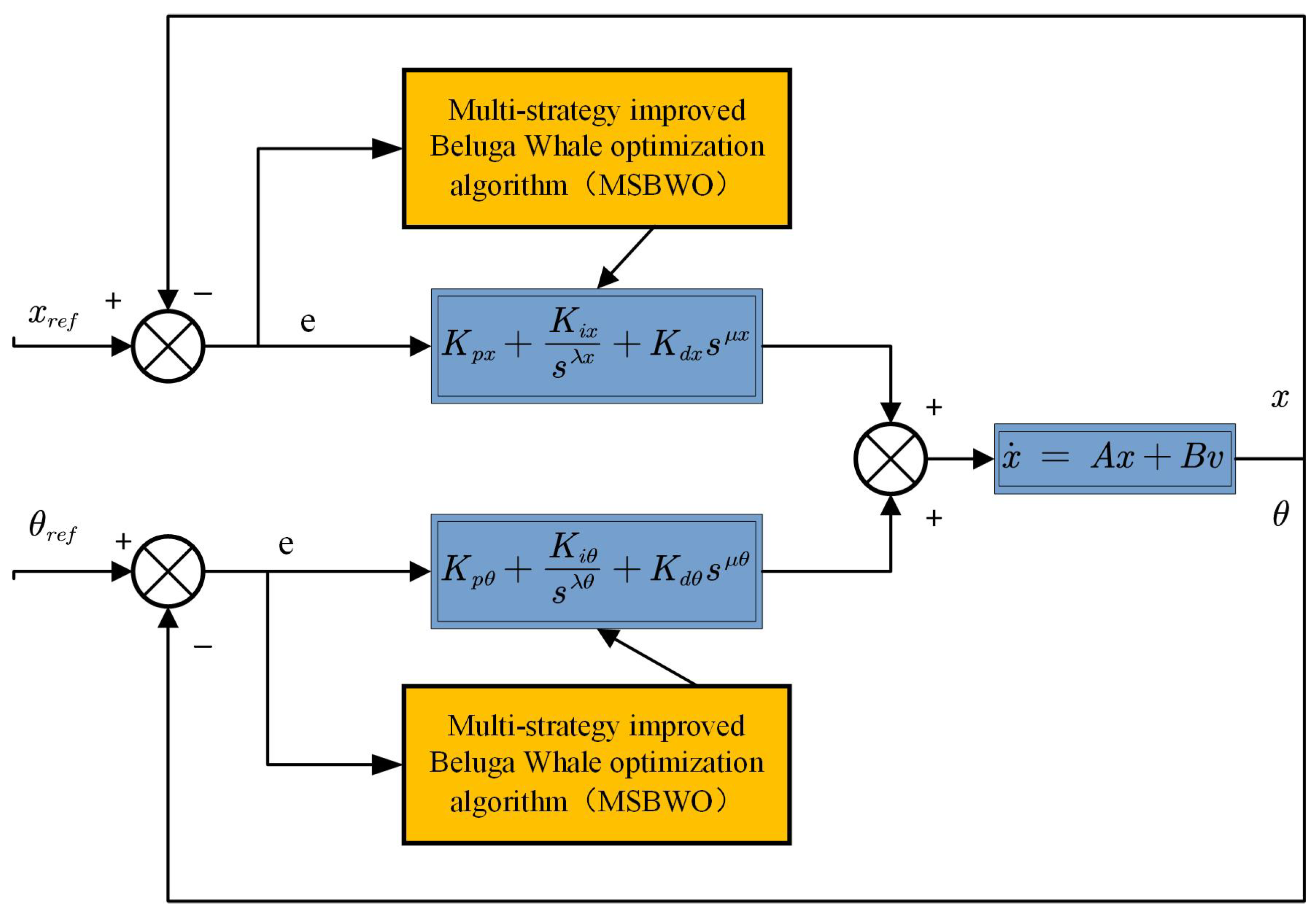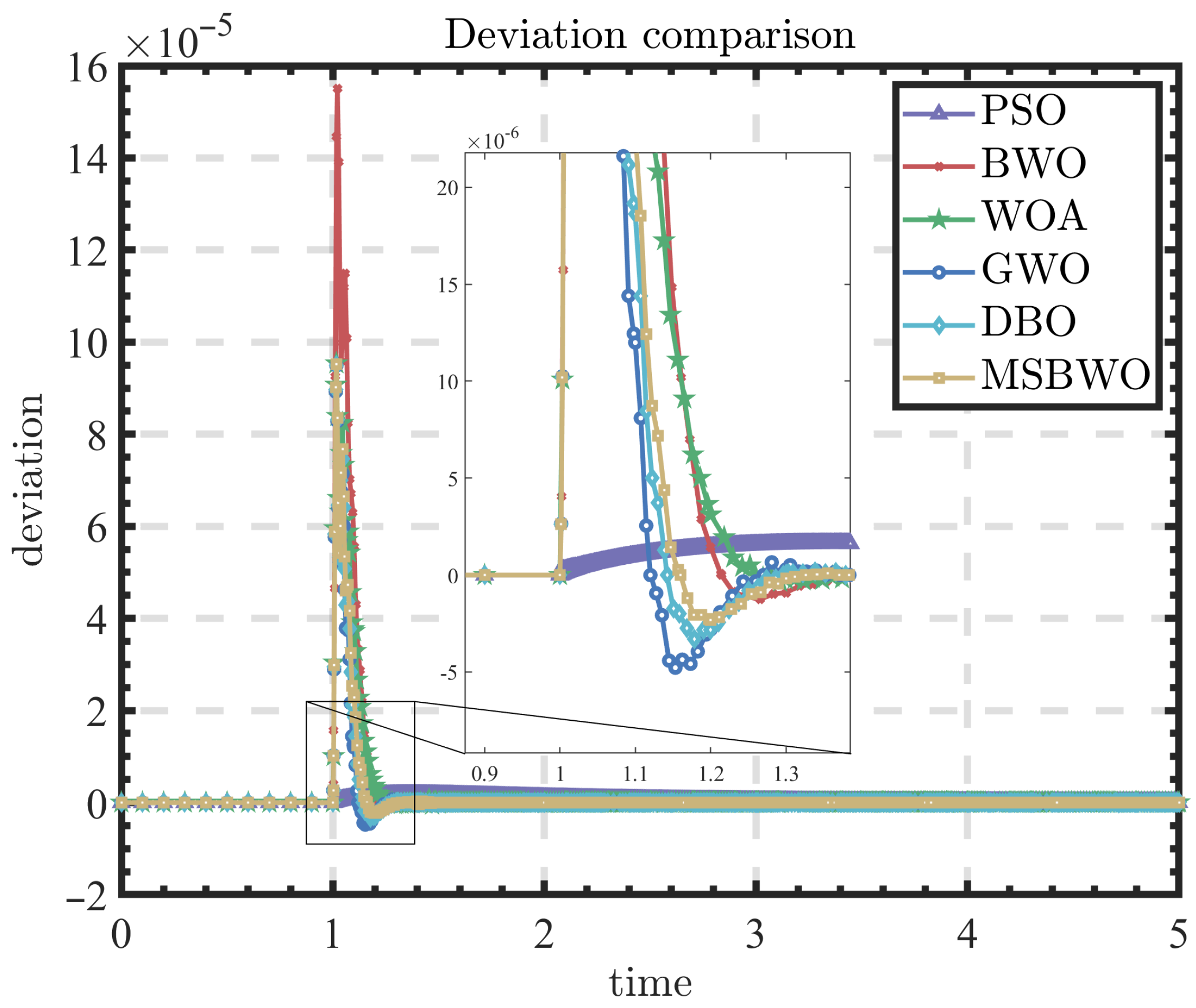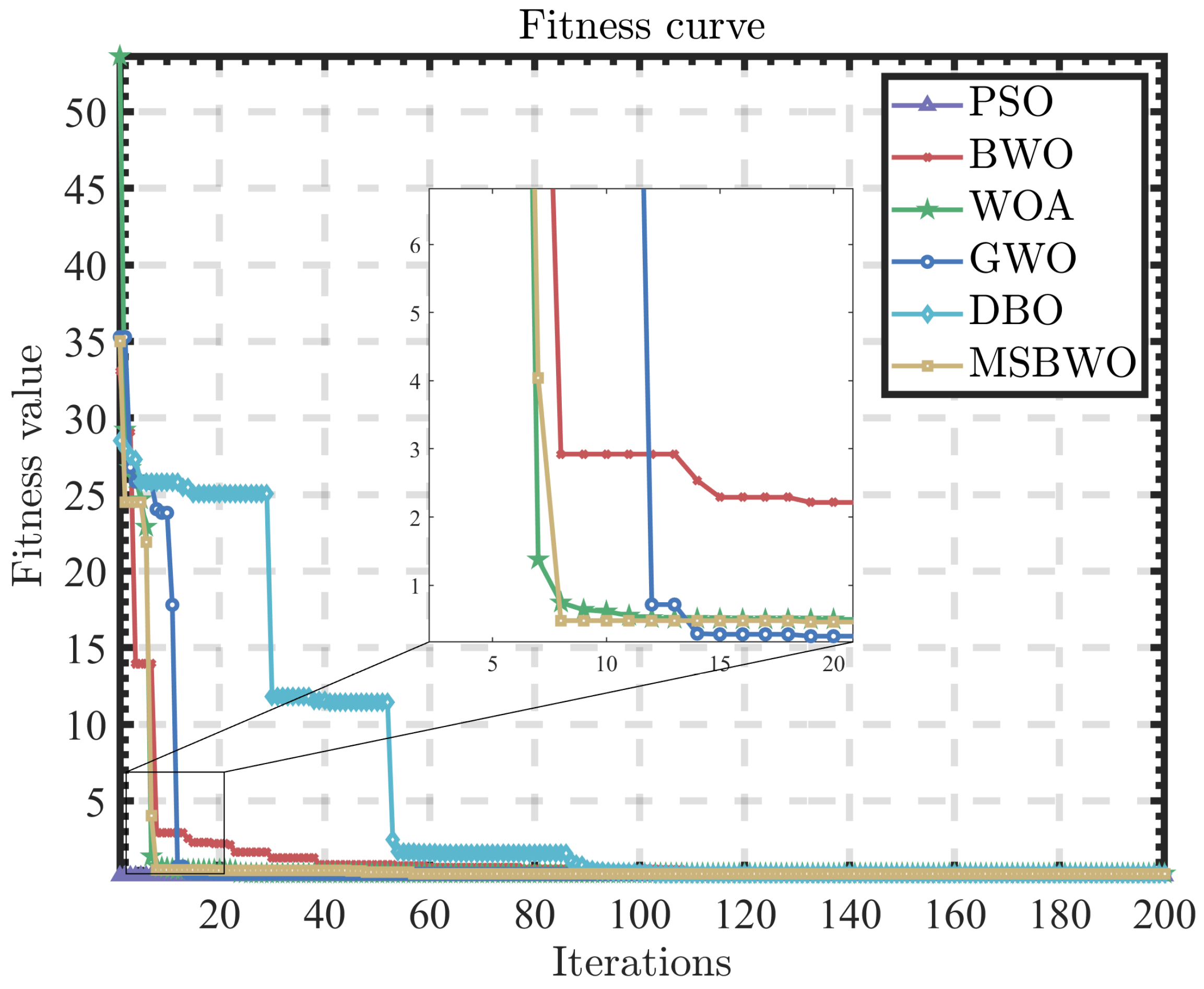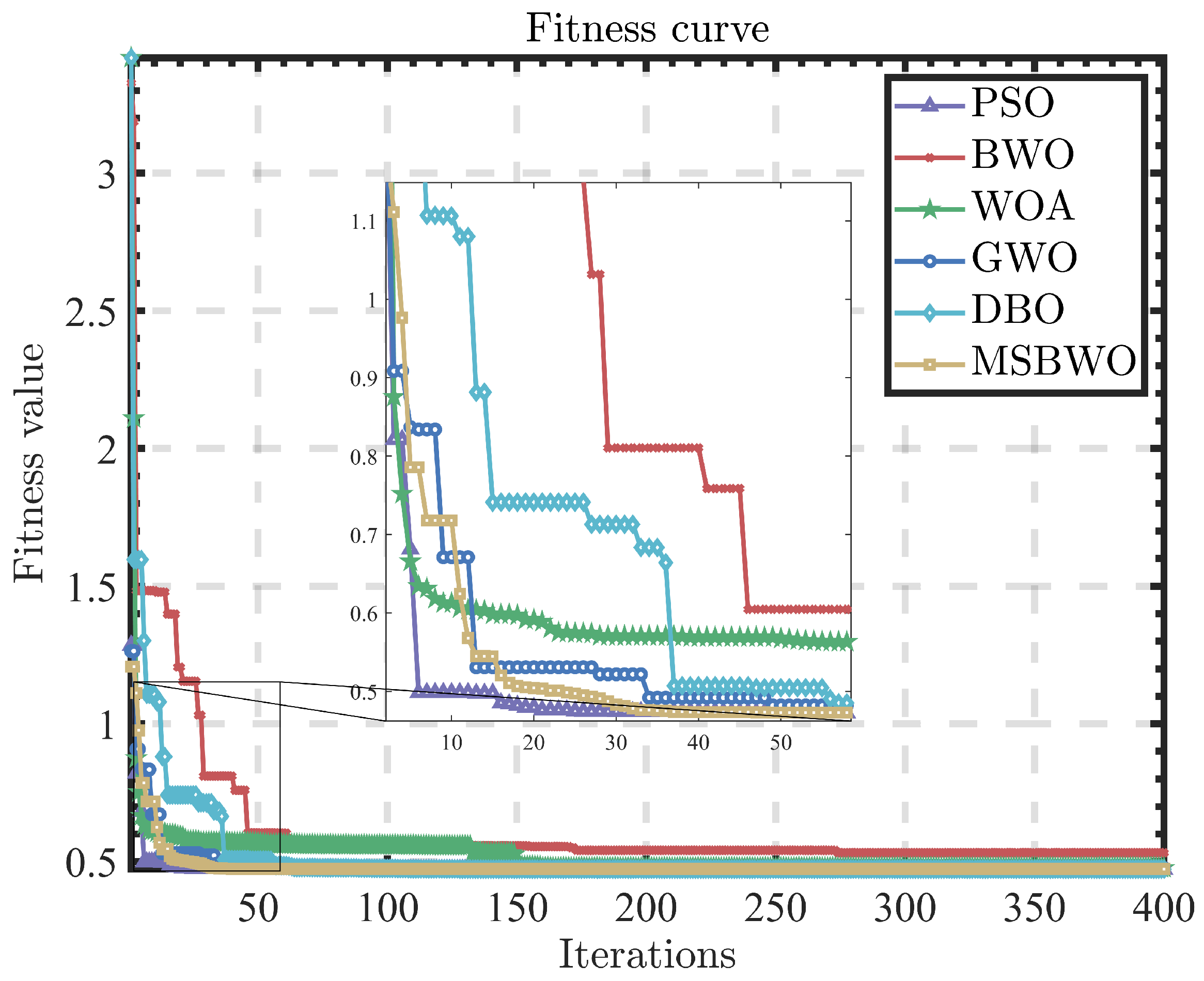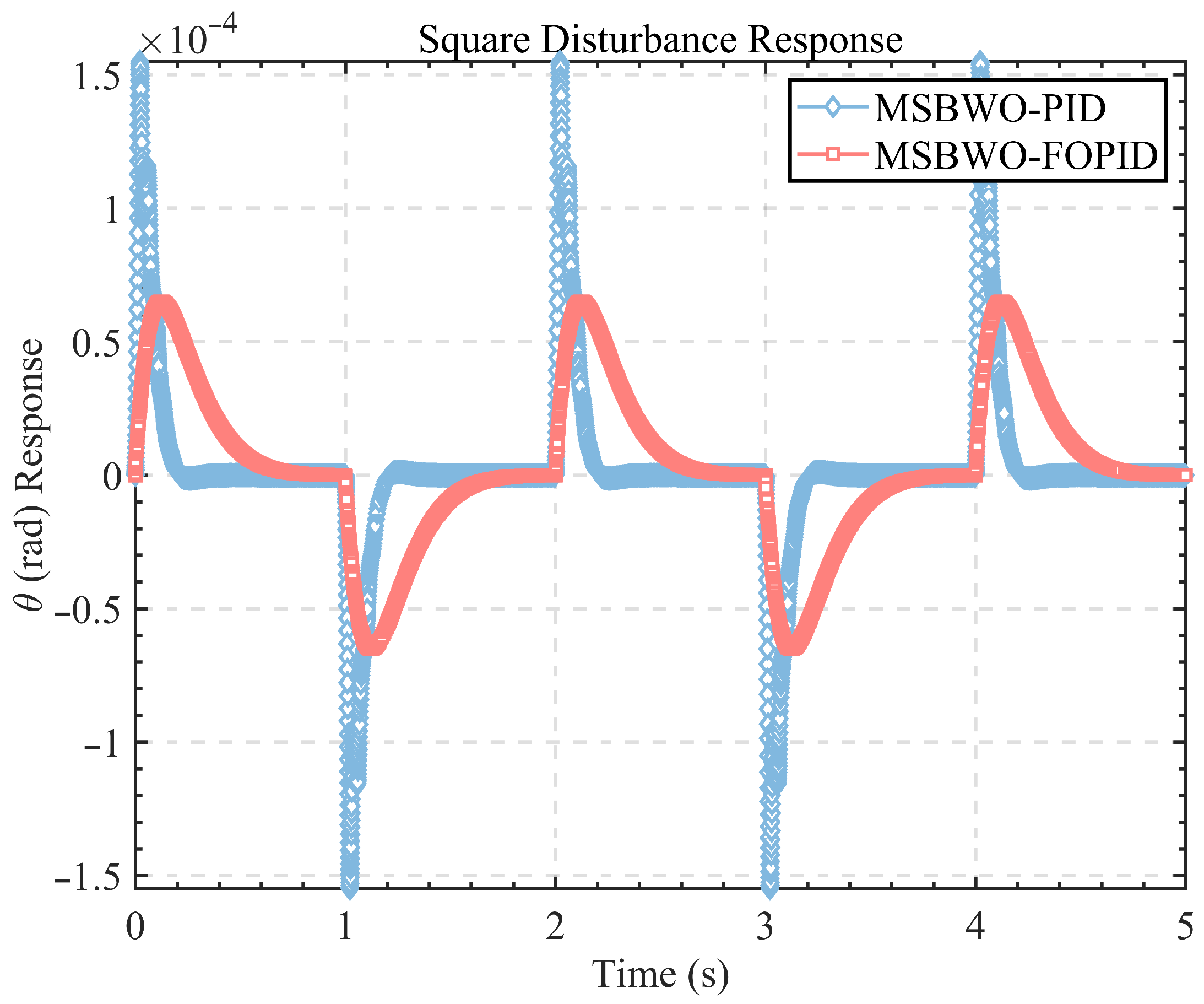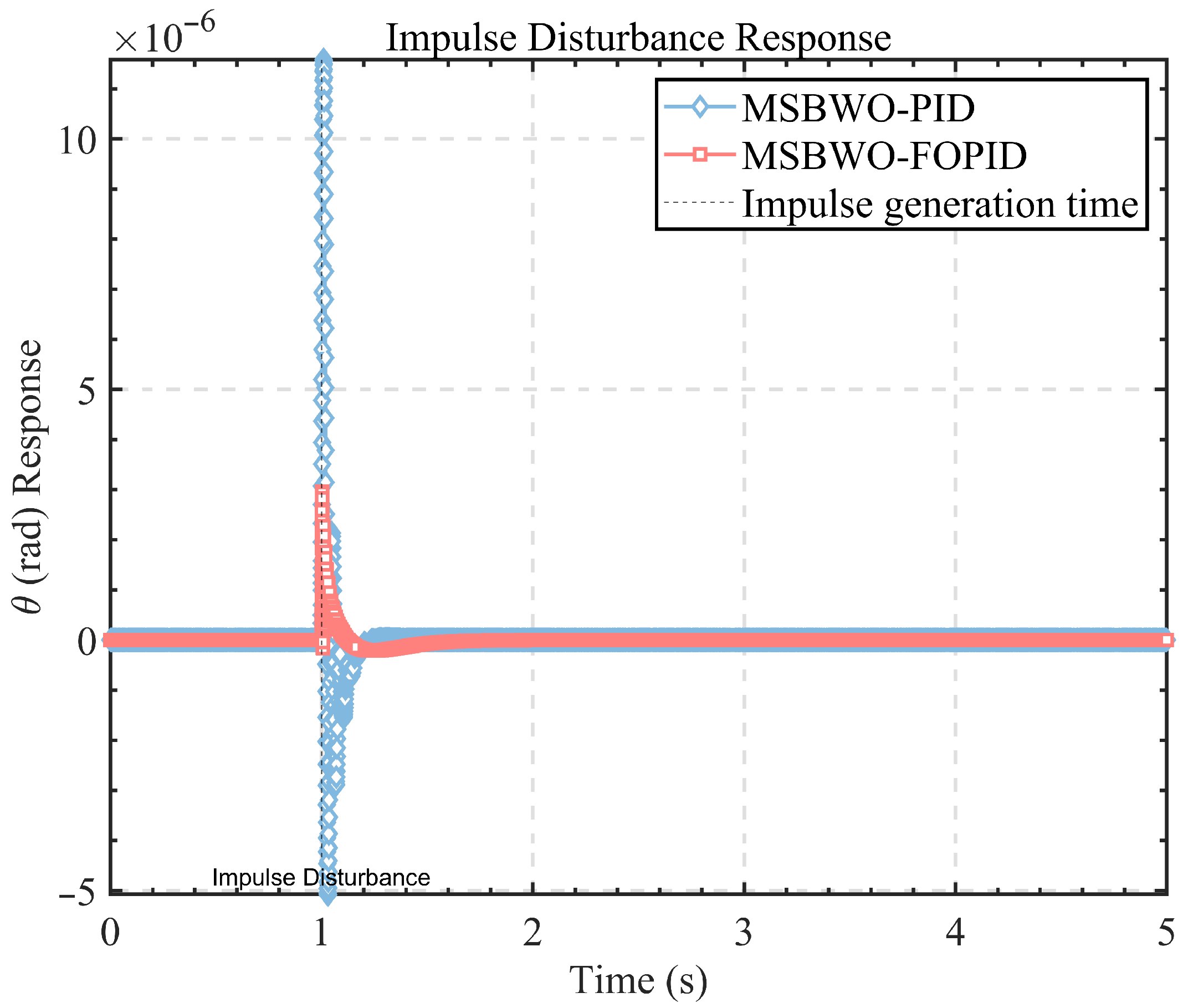5.1. Performance of the MSBWO Algorithm
In this study, several well-established swarm intelligence algorithms were selected for performance comparison with the proposed Multi-Strategy Improved Beluga Whale Optimization (MSBWO) algorithm. The benchmark algorithms include Particle Swarm Optimization (PSO), Whale Optimization Algorithm (WOA), Dung Beetle Optimization (DBO), Gray Wolf Optimization (GWO), and the original Beluga Whale Optimization (BWO). All of these approaches are nature-inspired metaheuristic algorithms derived from the collective behaviours of animals. These algorithms were chosen due to their popularity, demonstrated effectiveness, and relevance in solving complex optimisation problems.
Table 2 summarises the key hyperparameters used in the proposed Multi-Strategy Beluga Whale Optimization (MSBWO) algorithm. These parameters include the population size, maximum iterations for both PID and FOPID tuning, and the specific values for the Lévy flight index
, whale fall probability
, and spiral control factor
b. Additionally, the table lists the elite pool size, which is set to the top 3 candidates plus a weighted average, and the chaotic map used for initialisation, which is the improved Circle map. These hyperparameters were carefully chosen to balance exploration and exploitation in the optimisation process, contributing to the algorithm’s performance.
Figure 9 illustrates the convergence performance of the compared algorithms across the 23 test functions. In terms of convergence speed, the MSBWO algorithm demonstrates superior performance in most cases (e.g., F1, F2, F3, F4, F6, F10, F12). Although PSO and WOA exhibit competitive convergence rates on functions such as F7, F8, and F14, they generally lag behind MSBWO. Regarding global optimum accuracy, MSBWO achieves high precision on functions including F1, F2, F3, F4, F8, F10, and F12. While other algorithms like BWO and GWO show good performance on certain benchmarks, their effectiveness is not as widespread. In terms of stability, MSBWO consistently approaches the global optimum across most test functions. Although GWO and PSO display robustness on selected cases, their overall consistency remains inferior to MSBWO.
Based on this comprehensive evaluation, MSBWO exhibits the best overall performance among the tested algorithms, excelling in convergence speed, global accuracy, and solution stability.
Figure 10 presents box plots comparing the fitness distribution of the optimisation algorithms across the same 23 benchmark functions. The results reveal varying algorithmic performances. For instance, on functions F1, F3, F4, F5, F6, F7, F9, F10, F11, F12, F13, F15, and F18, PSO yields significantly higher fitness values, suggesting subpar performance. In contrast, MSBWO, along with BWO, DBO, GWO, and WOA, generally achieves lower and more stable fitness results on these benchmarks. On F2, all algorithms show relatively low fitness values, indicating limited difficulty. On F14, DBO performs the worst, while others maintain acceptable fitness. For F16, F17, F19, and F20, MSBWO again achieves the best performance with the lowest fitness values, followed by GWO, DBO, and WOA, while PSO continues to underperform.
In summary, MSBWO delivers superior performance on most benchmark functions in the CEC2005 suite, outperforming other algorithms in terms of accuracy and consistency. These results suggest that MSBWO is well-suited for similar complex optimisation problems. Conversely, PSO demonstrates limitations and may require enhancements or replacement with more effective methods in these scenarios. For detailed numerical results, please refer to Appendix
Figure A1.
5.2. Performance of the TWSBR Control System
In this study, a TWSBR model with integrated DC motor dynamics was developed, and both FOPID and traditional integer-order PID controllers were designed for balance and position control. Notably, when the FOPID parameters
, the controller reduces to a classic PID. The overall control structure is illustrated in
Figure 11, where two independent controllers are responsible for regulating the position (
X) and tilt angle (
), respectively. However, since both controllers function similarly, this analysis focuses on tilt angle (
) regulation, which is critical to the robot’s balance.
The control input is derived from the difference between the two controller outputs. The input to the physical system, modelled as a DC motor, is voltage. All simulations and controller optimisations were implemented in MATLAB 2023b with a sampling interval of
seconds. A step disturbance of 0.2 amplitude was applied at
s, and the reference angle was set to
. The system dynamics follow the state-space model defined in Equation (
66).
Table 3 summarises the key notations used in the dynamic modelling and control design of the two-wheeled self-balancing robot (TWSBR).
The FOPID controller has five tunable parameters, in contrast to the three of the conventional PID controller. Proper tuning is critical to ensure fast settling time, minimal overshoot, and low angular fluctuation in . To determine optimal parameters, six metaheuristic algorithms were applied: PSO, WOA, DBO, GWO, BWO, and MSBWO. Both PID and FOPID controllers were optimised using each algorithm and evaluated based on their system response and overall output error.
For the PID controller, each algorithm employed a population size of 30 and 200 iterations. For the more complex FOPID, the population size was 30 with 400 iterations to accommodate the increased search space. These settings were chosen empirically to balance performance and computational efficiency. Parameter bounds were for , , and (PID), and for , , , , and (FOPID).
Controller tuning was guided by standard performance metrics: IAE, ISE, ITAE, and ITSE:
Various objective functions combining these metrics were tested, including weighted sums incorporating overshoot and peak velocity. Coefficients were chosen via empirical tuning:
Figure 12 shows that the objective function
achieves the best performance in terms of both convergence and stability. Specifically, it converges rapidly to a near-zero value and maintains a consistently low deviation, even in the presence of initial oscillations. The robustness of
is evident, as it consistently outperforms other objective functions in reducing the steady-state error while minimizing overshoot. Consequently,
was selected as the preferred objective function for controller parameter optimisation in this study due to its superior performance in terms of both convergence speed and steady-state accuracy. As illustrated in
Figure 13, the fitness values demonstrate iterative convergence when optimising with different objective functions. Among them,
achieves the most stable and rapid convergence, further confirming its effectiveness for controller parameter optimisation.
By analysing the variation in system deviation over time (
Figure 14) and the evolution of fitness values over iterations (
Figure 15), a detailed comparative analysis was conducted for each algorithm based on key performance indicators, including overshoot, convergence time, and steady-state error.
Figure 14 shows that the MSBWO-PID algorithm demonstrated the best performance, exhibiting the smallest overshoot, the shortest convergence time, and rapid attainment of zero steady-state error. In contrast, the PSO-PID algorithm failed to converge properly, resulting in significant errors. Consequently,
Table 4 does not report its target value or iteration count. The GWO-PID algorithm exhibited relatively large overshoot and extended convergence time, while the BWO-PID and WOA-PID algorithms experienced large initial fluctuations and convergence times comparable to GWO. Among all, the DBO-PID algorithm yielded the poorest performance, with the largest overshoot and the slowest convergence.
Figure 15 shows that the MSBWO-PID algorithm again achieved superior results. It displayed the fastest initial decline within the first 20 iterations and reached the lowest final fitness value, approaching zero. In contrast, the PSO-PID, BWO-PID, WOA-PID, and GWO-PID algorithms showed slower convergence and higher final fitness values. The DBO-PID algorithm exhibited the slowest convergence and the highest final fitness value.
In summary, the MSBWO-PID algorithm outperformed all other methods in tuning the PID controller parameters for the TWSBR. It achieved minimal overshoot, the fastest convergence, the lowest steady-state error, the steepest initial fitness decline, and the lowest final fitness value. Conversely, the other algorithms suffered from varying degrees of fluctuation, significant overshoot, and sluggish convergence. Therefore, the MSBWO-PID algorithm is validated as the most effective approach for PID parameter optimisation in TWSBR applications.
By analysing the deviation of the system over time (
Figure 16) and the evolution of the fitness value across iterations (
Figure 17), a detailed comparison was conducted among the algorithms based on key indicators such as overshoot, convergence time, and steady-state error. The results of TWSBR FOPID parameter tuning show that the MSBWO-FOPID algorithm outperforms the others in terms of convergence speed, control stability, and optimal fitness value. Specifically, it achieves the fastest convergence and the smallest deviation.
Figure 16 shows that the MSBWO-FOPID algorithm exhibits the lowest overshoot and the shortest steady-state time. The deviation decreases rapidly and stabilises within approximately one second, which is significantly faster than the other algorithms. In contrast, the BWO-FOPID and WOA-FOPID algorithms show slower convergence and longer settling times, while the GWO-FOPID and DBO-FOPID algorithms display moderate convergence and stabilisation performance.
Figure 17 shows that the MSBWO-FOPID algorithm again demonstrates superior performance, with its fitness value decreasing rapidly and stabilising after approximately 50 iterations, reflecting strong optimisation capability and fast convergence. Although the PSO-FOPID and DBO-FOPID algorithms also exhibit relatively fast convergence, their fitness fluctuations are minimal. Meanwhile, the BWO-FOPID and WOA-FOPID algorithms display significant fluctuations and slower convergence.
In summary, the MSBWO-FOPID algorithm achieves the best overall performance in terms of overshoot, steady-state time, convergence speed, and fitness value. Therefore, it is recommended as the preferred method for optimising FOPID parameters in TWSBR control applications.
Table 4 and
Table 5 present the objective function values and iteration counts for PID and FOPID control, respectively. In
Table 4, the performance of each optimisation algorithm for PID control is summarised. GWO-PID and DBO-PID achieve the lowest objective values of 0.2349 and 0.2347, respectively, with GWO-PID requiring only 14 iterations, indicating the fastest convergence. However, as shown in
Figure 14, both GWO-PID and DBO-PID exhibit substantial overshoot. The MSBWO-PID algorithm also demonstrates strong overall performance, achieving an objective value of 0.2389 within 57 iterations, reflecting a good balance between accuracy and convergence.
In
Table 5, the FOPID control results indicate that MSBWO-FOPID outperforms other algorithms, achieving the lowest objective value of 0.4726 with only 36 iterations. This highlights the MSBWO algorithm’s effectiveness in tuning FOPID controllers, enabling rapid convergence with fewer iterations.
Table 6 and
Table 7 report detailed performance indicators for PID and FOPID controllers. According to
Table 6, PSO-PID performs best in terms of IAE, ITAE, ISE, and ITSE. However, it lacks convergence characteristics and requires the longest time to reach steady state. In contrast, GWO-PID and MSBWO-PID are superior in overshoot (OS) and steady-state time (ST), with MSBWO-PID achieving the shortest ST of just 0.319 s, demonstrating rapid dynamic response.
For FOPID control,
Table 7 shows that although BWO-FOPID performs well in IAE, ITAE, ISE, and ITSE, its stabilisation time is excessively long, as also evidenced in
Figure 16. The MSBWO-FOPID algorithm achieves the lowest overshoot (
) and shortest steady-state time (0.852 s), further confirming its superior performance.
Table 8 and
Table 9 list the controller parameter values for PID and FOPID controllers, respectively, under different optimisation algorithms.
The numerical results in
Table 4 and
Table 5 present the objective function values for PID and FOPID controllers, respectively. These values are meaningful only within the same controller category (i.e., PID vs. PID, or FOPID vs. FOPID). Direct cross-comparison between
Table 4 and
Table 5 is inappropriate, as the inclusion of fractional orders
in the FOPID introduces additional design flexibility, primarily enhancing robustness and frequency-domain characteristics rather than minimising the time-domain aggregated objective. Similarly, the error-based indicators in
Table 6 and
Table 7 (IAE, ITAE, ISE, ITSE) are intended for intra-category evaluation and should be interpreted within this context.
In the performance comparison, we focus on transient metrics such as overshoot (OS) and settling time (ST), as well as system responses shown in
Figure 14 and
Figure 16. For instance,
Table 6 indicates that the best PID design (MSBWO-PID) achieves a settling time of
s but suffers from an overshoot of
. In contrast,
Table 7 and
Figure 16 show that the MSBWO-FOPID achieves the lowest overshoot (
) and smooth recovery, confirming its superior robustness and dynamic stability. The trajectory responses in
Figure 14 and
Figure 16 further highlight that FOPID controllers, when optimised by MSBWO, exhibit faster damping of deviations and more reliable disturbance rejection. Although the FOPID controller may require slightly more time to reach steady state, it maintains smaller deviation fluctuations and greater stability, particularly in dynamic and disturbed environments.
In conclusion, the integration of the FOPID controller with the MSBWO optimisation algorithm results in significant improvements in control accuracy, stability, and robustness, making it highly suitable for complex systems with stringent performance requirements. While the conventional PID controller demonstrates strong performance, the FOPID controller, particularly when optimised using the MSBWO algorithm, offers substantial advantages in deviation suppression, convergence speed, and overall optimisation effectiveness.
